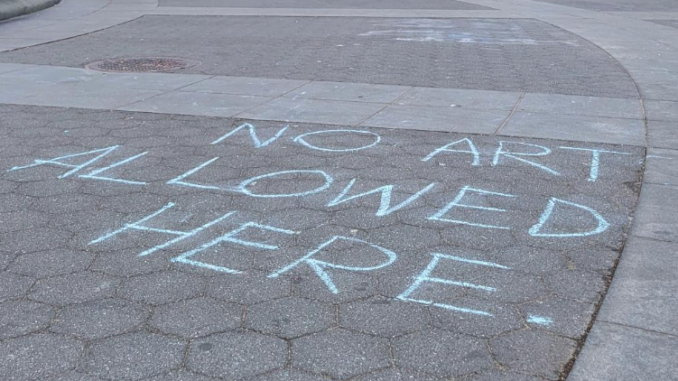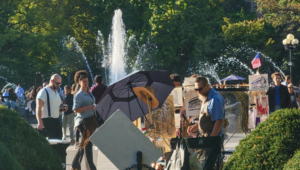
BY IAN M. TORRES
Officials from the New York City Department of Parks and Recreation, with the help of the New York Police Department began enforcing new rules in Washington Square Park on Friday, September 27. The new crackdown affects the livelihoods of many artists, as they’re being told they cannot display their art within 50 feet of the fountain or risk getting a summons and having their property confiscated and evicted altogether.
Washington Square Park has long been a common ground for artists and musicians from a wide variety of backgrounds and practices. Buskers and expressive matter vendors have been welcome in the park, but must follow the city’s rules and regulations the same way any park visitor would have to. After many decades without issue, artists currently find themselves in a difficult and what they say is an unfair position.
Eric Cook, an artist who has been creating and displaying his art in the park for close to a decade, like many other artists, is frustrated by this sudden change in regulations. “There’s a rule called the monument rule and it says that you cannot display anything within 50 feet of a monument. Now this entire park is a ‘monument,’ so it’s really the rule to keep artists out of the park,” he said.
According to New York Parks Department, the enforcement policy is to first begin with a period of education, where they explain what the rules and regulations are to new park goers that they find violating them, before moving on to eviction.
Within only a few days, an arrest was made after an artist would not show his I.D., refusing to move when officers asked him to do so. “I watched the park rangers harass [the] artist for hours before they finally took him away in handcuffs and seized his property. The main reason is that he was too close to the fountain but they’ll try and tell you otherwise,” said Cook. “They’re irrationally enforcing a rule that has never been enforced for 20 years,” he added.
As part of NYC Parks’ mission, these rules are in place to help balance all the various ways park goers can use the park; from a quiet place to read and reflect to a concert venue for new musicians.
Washington Square Park is funded by a combination of public tax dollars, private donations, and the Washington Square Park Conservancy. A non-profit organization working alongside NYC Parks and neighborhood groups, the WSP Conservancy ensures that the park continues to be a diverse and historical urban green space by working with volunteers and raising funds to help keep the park clean and safe for everyone. As per WSP Conservancy, there is no legal agreement, operational or otherwise, between the Parks Department and the Washington Square Park Conservancy. The conservancy essentially provides support for the park through
stewardship, financial support, and programming.
For artists, this recent harassment opens up discussion about the lack of enforcement against drug dealers/users who occupy space in only two designated areas within the park where artists are allowed to display their work, albeit while following proper guidelines.

Saturday, October 5, 2024. (Photo by Ian M. Torres)
Artist and former educator, Oriel “OR1EL” Ceballos, has been selling and creating his art for a decade. A Brooklyn College, Princeton and Columbia University alumni, he graduated from seminary school at the age of 24 and at 31, began teaching. “Teaching college, that kind of shifted my perspective on what it means to be a successful black man in America,” said Ceballos. “So, all I told them, what I encourage other artists to do – I don’t have any price, I’m displaying art so if you shut me down, I’m still gonna stay here, because as a pedestrian I can be in the park and I can just go to Michael’s and just create an installation while I’m now just live painting here. I don’t really understand why artists are leaving.”
The Conservancy cherishes the park’s history as a center for artists, which is part of why they began an artist residency program to introduce various practices and local artists to the community within regulations. “I got arrested here for selling art this way – and look, I’m still doing it. I sued the city, ended up doing shows… I got a gallery, I don’t really need to be out here,” he added.
“Don’t let them stop your money. You gotta be a little crazy, you gotta have an edge when it comes to your art.
